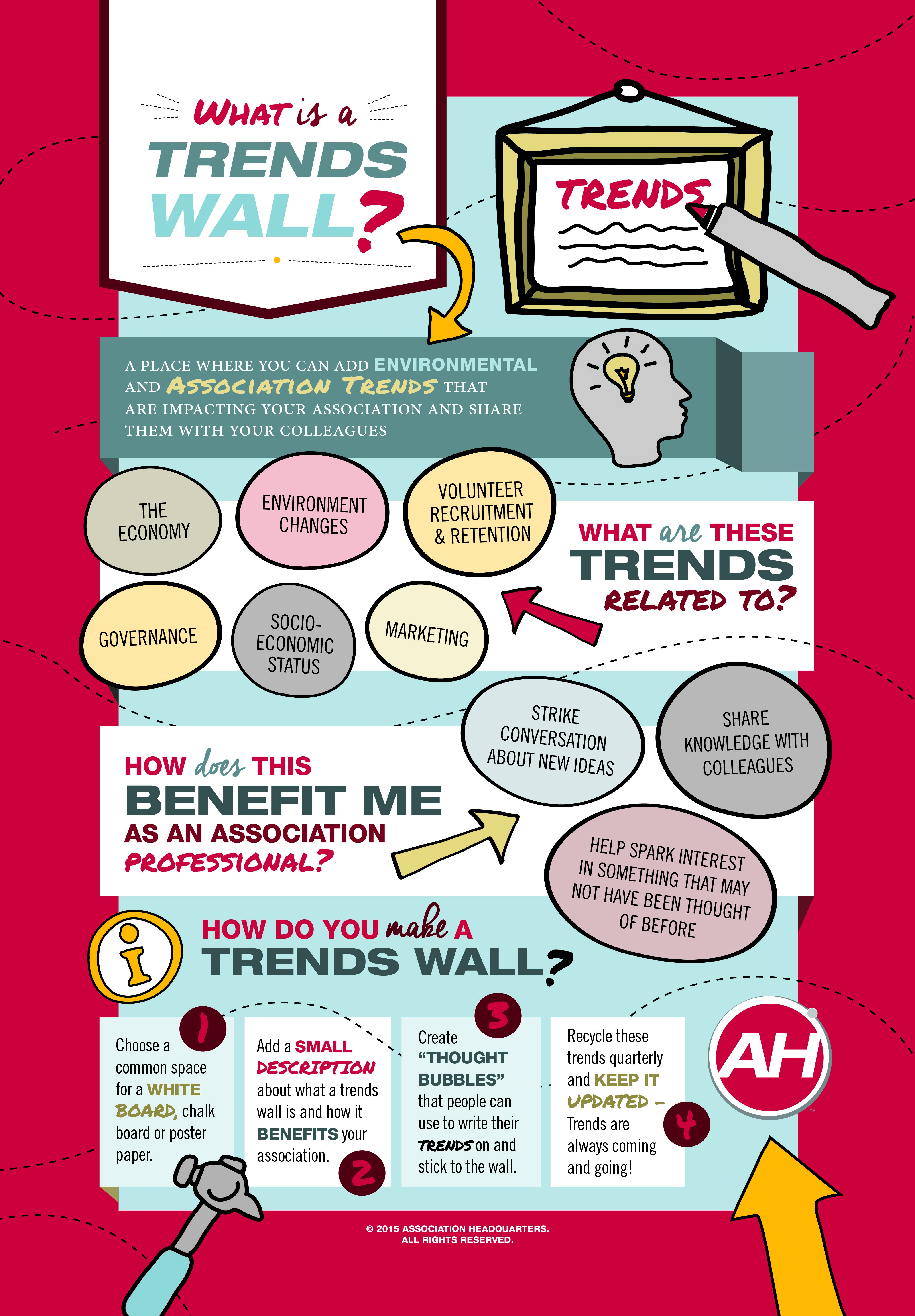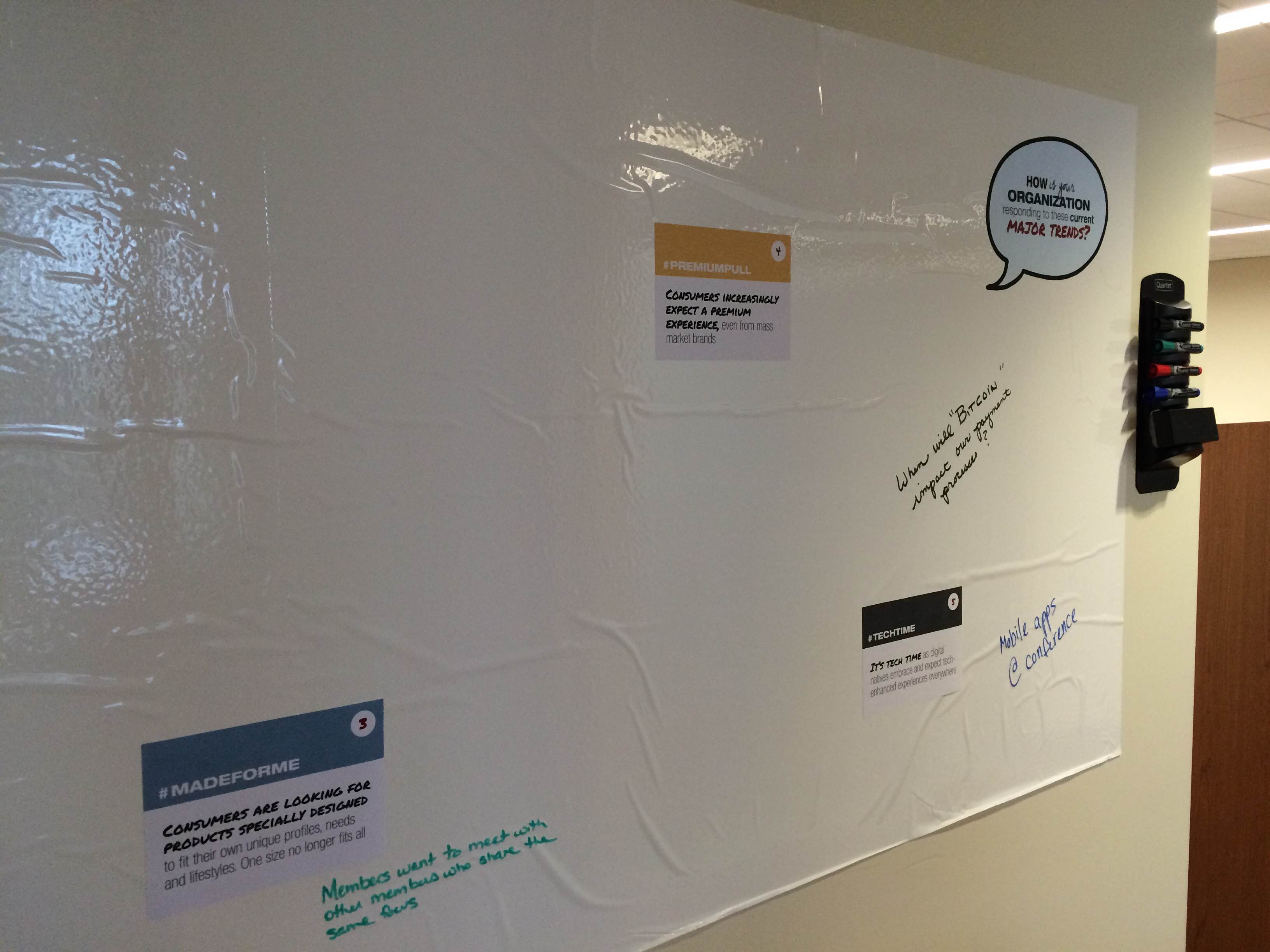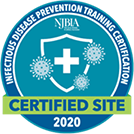I’m more than a little excited to share that the AH Trends Wall has arrived and is located directly outside my office at AH! Together with our Innovation Champions Committee, marketing and design help, our vision came to life.
What is a Trends Wall?

A trends wall is a place where people, as part of an Association Management Company (AMC), can come together to write down trends that they are seeing within their association, as well as in their environments. These trends can relate to membership, technology, economics, social status, environmental, etc. When you write a trend on the Trends Wall, you help spark conversation and ideas among your peers, which has a direct benefit on each association partnered with an AMC.
There are two primary purposes for this initiative:
- The rollout of the AH Trends Wall allows us to “pilot” the tool for possible use at board or member meetings. We can take the opportunity to work through any functional issues internally before using it as a growth tool with our client partners.
- Ultimately, this wall allows AH’ers and guests to offer their thoughts about how hard and soft trends could or will change the way we deliver services to our client partners and even how the trends are going to impact the way your members interact with their customers.
Please join me in sharing the new ideas that you are reading or observing. If you're in the building, stop by and add your thoughts! If you're not, add your throughts in the comments and we will get them up on the AH Trends Wall!

 The AH Trends Wall outside of my office
The AH Trends Wall outside of my office
The article below highlights the reason for my drive. Daniel Burrus shares, In Flash Foresight, that the impact and change is only disruptive when it comes from the outside in. There is an alternative to living as a constant crisis manager: taking the initiative to become an opportunity manager.
Dealing effectively with any future is not so much about getting it right, but more about exercising what I call your “foresight muscles” and preparing for a range of different potential futures, just like you’d prepare for the range of whether you encounter trekking in Nepal. The more you stretch your thinking and work through what different — perhaps even very strange — potential futures could look like (and what you could do in response to them), the better prepared you are for any of them if and when they arrive and become your today.
Daniel Gilbert’s research indicates that people always estimate the amount of change that will happen in the future is far less than what they know has happened in the same amount of time in the past. When you add the accelerating rate of change to that it gets tricky. In Back to the Future, Marty McFly goes from 1985 to 1955. Imagine the movie were made today and he went from 2015 to 1985. In 1985 there were no mobile phones, personal computers, the Internet, digital cameras — and that is only technology. There is a much bigger difference in the past 30 years than the previous 30. Ray Kurzweil calls this the Law of Accelerating Returns. He believes that the 21st century will achieve 1,000 times the progress of the 20th century, and other scientists agree. So it is no wonder that we find it difficult to imagine what potential futures could be like.
In the present moment any and all futures are a surprise. If you prepare for different surprising futures you flex your “foresight muscles” for each of them, so that you have a plan A, B, and C. You plot a plausible path for how you would get from today to that particular potential future. Plotting the path will help you to notice when you are proceeding along that path in reality, so that you can take advantage of your Plan B for that particular path/future, engaging the appropriate strengths for the advantage of your business. You know what these are because you have thought about it beforehand.
So, here are some things you might like in your backpack to think about sufficiently ‘far out’ futures:
- You can read or watch science fiction and take notes of things that could affect you.
- You can pay attention to the newest advances in medicine, technology, and thinking. Imagine what happens when different trends meet, merge, and have babies.
- You can develop a set of potential futures (in a diverse team) — challenge your thinking and assumptions, bring crazy ideas in, and build on each other’s ideas.
- You can ask ‘What if…?’ and ‘What else?’
- And you can think about what your Plan A, B, and C would be in each of these potential futures.
Don’t approach the foreign country of the future unprepared — make sure you’ve got a well-appointed backpack.




